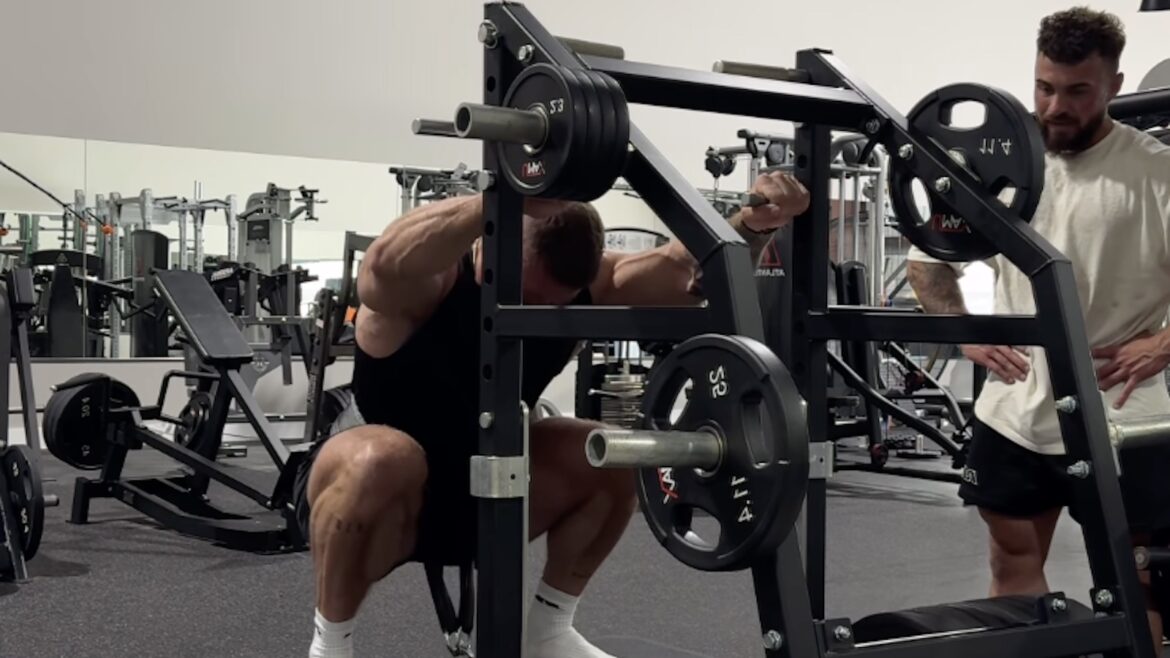“CBum” is leveraging tempo training and tri-sets to sculpt bigger legs for the 2024 Olympia.
Building a well-rounded physique requires dedication to training all muscle groups, though they are not equal. The posterior chain — particularly the glutes and hamstrings — are often overshadowed by ‘mirror muscles’ of the upper body and quads.
The reigning, five-time Classic Physique Olympia champ Chris Bumstead has mastered the art of carving a championship-caliber physique and aims to defend his title at the 2024 Olympia, scheduled for Oct. 10-13 in Las Vegas, NV.
Bumstead’s Olympia prep involves two weekly leg workouts: one for quads and another for hamstrings and glutes. On Aug. 9, 2024, he pulled back the curtain on his hamstring and glute-building techniques.
Chris Bumstead’s Hamstring & Glute Workout
[Related: The Anatomy of Your Leg Muscles, Explained (and How To Train Them)]
[Related: How Many Calories Are in Derek Lunsford’s 2024 Olympia Shredding Diet?]
Lying Leg Curl
Bumstead opens with an isolation exercise to pre-exhaust his muscles. This is to achieve greater tissue stimulation in subsequent compound exercises without needing excessively heavy weights. The 29-year-old Bumstead performed a double drop set.
Bumstead begins with a 4-0-X-1 rep tempo: a four-second negative, no pause at the bottom, an explosive concentric, and a one-second hold at the top. After a 10-second rest, he switches to a 4-0-X-0 tempo, eliminating the pause in the fully shortened position. Following another 10-second break, he transitions to a 3-0-X-0 tempo.
A study published in The Journal of Physiology concludes that a slow rep tempo leads to greater muscle protein synthesis compared to faster repetitions due to the increased time under tension (TUT). (1)
Tri-Set — Seated Hamstring Curl, Hyperextension, Cable Pull-Through
Bumstead starts with seated hamstring curls biasing the fully lengthened position. Forty-five-degree hyperextensions focus on the mid-to-lengthened range, whereas cable pull-throughs engage the hamstrings in the mid- and fully-shortened positions.
Bumstead extended his legs, and his toes pointed outward during cable pull-throughs. On the eccentric, he pushed his hips and knees backward while keeping his chest proud to achieve a deep glute and hamstring stretch.
Dumbbell Romanian Deadlift
Before starting RDLs, Bumstead performed a set of garhammer raises to relieve lower back stiffness. This trunk flexion exercise effectively alleviates tightness.
Bumstead employs one-and-a-half reps on the RDLs to maximize glute and hamstring fiber activation. This technique involves lowering the dumbbells to mid-shin level, partially returning to a 45-degree torso angle, and then lowering again to mid-shin level before completing the full rep.
Bumstead notes that he should start the hamstring-focused workouts with RDLs due to his lower back’s limited work capacity. Performing them later, after hyperextensions and cable pull-throughs, compromises hamstring and glute activation.
Adductor Machine & Standing Calf Raise
Recognizing that tight adductors contribute to lower back stiffness, Bumstead transitions to two sets on the adductor machine with a controlled 2-2-2-2 tempo.
During standing calf raises, Bumstead employs four-second eccentrics with a pause in fully lengthened and shortened positions. As the set progresses, he picks up the pace and performs lengthened partials to maximize gastrocnemius engagement. (2)
More Bodybuilding Content
References
- Burd NA, Andrews RJ, West DW, et al. Muscle time under tension during resistance exercise stimulates differential muscle protein sub-fractional synthetic responses in men. J Physiol. 2012;590(2):351-362. doi:10.1113/jphysiol.2011.221200
- Kassiano, W., Costa, B., Kunevaliki, G., Soares, D., Zacarias, G., Manske, I., Takaki, Y., Ruggiero, M. F., Stavinski, N., Francsuel, J., Tricoli, I., Carneiro, M. A. S., & Cyrino, E. S. (2023). Greater Gastrocnemius Muscle Hypertrophy After Partial Range of Motion Training Performed at Long Muscle Lengths. Journal of strength and conditioning research, 37(9), 1746–1753. https://doi.org/10.1519/JSC.0000000000004460
Featured image: @cbum on Instagram
